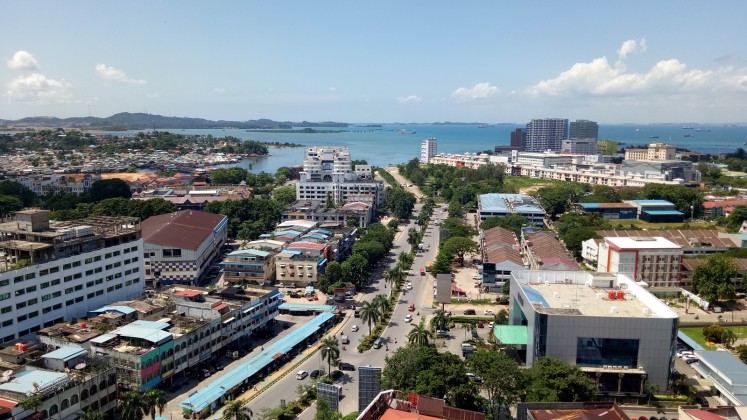Please Update your browser
Your browser is out of date, and may not be compatible with our website. A list of the most popular web browsers can be found below.
Just click on the icons to get to the download page.
Or continue login with
The popularity of the Nagoya area of Batam, Riau Islands, as an entertainment hot spot, shopping center and Chinatown is unquestionable, although the name has never been formally acknowledged and has been passed on only by word of mouth.
Reminding people of Nagoya in Japan, the name indeed came from the Japanese people working for Taisei International Corporation, the Japanese infrastructure company that built the Batu Ampar seaport and the Nongsa dam in Batam back in the 1970s. They called this area of Lubuk Baja, where they used to drink and eat, Nagoya.
"People still call [the area] Nagoya, although it has never become an official name," said the chairman of the Rukun Khazanah Warisan Batam community, Machmur Ismail, who was also a former chairman of the Malay Customary Institution (LAM)'s Batam city branch.
Machmur, who worked for the same company at the time, said the name Nagoya had started to be frequently mentioned in 1978.
"When I was small, we called the area as Lubuk Baja, which has been officially adopted as the name of the district," Machmur said.
The popularity of Batam’s Nagoya has even reached Japan itself, especially the people of Nagoya, the fourth biggest city in the country. This has attracted a TV station from Nagoya to send crews to reveal the history of Nagoya in Batam.
Machmur Ismail was one of the sources interviewed by the TV crew.
"They feel there is a relationship between Nagoya in Japan and Nagoya in Batam. They feel a sense of belonging," Machmur said.
He added that, even though Nagoya was only an informal name, local administration officials, including the mayor, always referred to the area as Nagoya.
Read also: Batam now nail care haven for Singaporean tourists A view of Batam’s Nagoya area near the sea. (JP/Fadli)
A view of Batam’s Nagoya area near the sea. (JP/Fadli)
When developing Batam in the 1970s, then Research and Technology Minister cum chairman of the Agency for the Assessment and Application of Technology (BPPT) BJ Habibie brought in many smart young people to develop the island, which at the time was a town of only some 6,000 people on newly cleared forest land, with limited infrastructure and entertainment facilities.
One of them was Tjahjo Prionggo, who is now the only engineer from the first period of the Batam Industrial Development Authority still working for the institution currently known as BP Batam.
Tjahjo said that Sekupang was among the first areas equipped with facilities such as seaports, roads and pedestrian zones modeled after Singapore's concept. Yet, many local employers refused to be placed in Sekupang and Batam Center, believing the areas were parts of the dragon's stomach and tail, according to Chinese feng shui practice, hence considered being located there a bad omen for business.
These local employers instead targeted Nagoya, which they believed to be part of the dragon's head.
"This explains why the development of the two areas lagged behind Nagoya a bit," Tjahjo recently told The Jakarta Post.
He said naming a place in Batam was often related to what was seen at the respective place. As an example, he pointed to Simpang Frengky, the intersection where mega apartment Pollux Meisterstadt Habibie is currently located. The place was named as such because, at the time, there were piles of big construction spikes there. The spikes were to be used to develop a hospital, but as the hospital never got built and the spikes were left piling up, people called the place Simpang Frengky to refer to the name Frengky Piles written on the spikes.
The same was the case with Simpang Jam, which was named after the clock built in the middle of the intersection by Bank Dagang Negara (BDN). The name is maintained until now, although the clock is no longer there and the bank had been liquidated.
Regarding Nagoya, there is no clear explanation so as to why it was named as such, except that it was the place where Japanese workers back then used to spend time to drink and eat.
Batam in the 1980s to 1990s was known as a haven for branded fashion, imported fruits, garlic and electronics.
Tjahjo noted the population growth in Batam was among the highest in Indonesia, once even reaching 26 percent a year, thanks to migration from other regions of Indonesia.
“At that time Batam became a magnet, a place where people come to pursue their dreams,” Tjahjo said, adding that, when he arrived in 1989 and settled permanently in Batam in 1992, the name Nagoya was already popular.
He said the Nagoya area stretched from Jl. Raden Patah in front of the Lubuk Baja Police station to the Jodoh area in front of the Travelodge hotel. The shopping center in the area is known as Nagoya.
Until 2005, the area was known for its karaoke parlors, Japanese-style bars and prostitution.
None of that can be found today, except for a number of Japanese restaurants.
According to Statistics Indonesia (BPS), Batam is home to 1.37 million people, most of whom are migrants from other regions. (yun/kes)
© 2016 – 2022 PT. Bina Media Tenggara